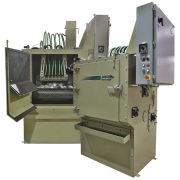A sandblasting cabinet, also known as a sand blast cabinet or abrasive blasting cabinet, is a specialized piece of equipment used for a wide range of surface preparation and finishing tasks.
It’s a controlled environment that allows operators to direct a stream of abrasive material, such as sand, grit, or beads, at a target surface using compressed air. This process effectively removes rust, paint, scale, or contaminants from the surface, leaving it clean and ready for further treatment, such as painting, coating, or inspection.
The primary purpose of a sandblast cabinet is to contain the abrasive blasting process within an enclosed workspace. This design serves multiple functions:
Operator Safety: By confining the blasting process, a sandblast cabinet shields the operator from direct contact with abrasive materials, preventing potential injuries. Operators can manipulate the objects being blasted without being exposed to the flying abrasive particles, dust, or contaminants.
Environmental Protection: Traditional open-air blasting can release harmful particles into the surrounding environment, posing health risks and creating a messy workspace. A sandblast cabinet effectively captures and contains these particles, providing a cleaner and safer working environment. This containment is particularly important when dealing with hazardous materials.
Precise Surface Treatment: Sandblast cabinets enable precise control over the blasting parameters — air pressure, abrasive type, nozzle size, and blasting duration. This control allows operators to achieve the desired surface finish without causing damage to the underlying material.
The construction of a sandblast cabinet involves a sturdy and durable enclosure made from materials like steel to withstand the forces generated during the blasting process. It features gloves or armholes through which the operator can access the interior of the cabinet while keeping their hands protected. A transparent window, often made of laminated safety glass, allows the operator to observe the blasting process without being exposed to the abrasive material.
Sandblasting Cabinet Applications
One of the notable benefits of using a sandblast cabinet is its versatility. It’s employed in various industries, including automotive, aerospace, manufacturing, restoration, and crafts. Some common applications include:
Surface Preparation: Sandblast cabinets are crucial for preparing surfaces before painting, coating, or bonding. By removing old paint, rust, and contaminants, they create a clean, keyed surface that promotes adhesion.
Restoration: When restoring old machinery, vehicles, or structures, a sandblast cabinet is often used to strip away years of corrosion, paint, and grime, revealing the original surface underneath.
Finishing: In the crafting and manufacturing industries, sandblast cabinets are utilized to achieve specific surface textures and finishes on materials like glass, metal, or plastic.
Cleaning: Sandblast cabinets are effective for cleaning delicate or complex parts that can’t be cleaned easily using other methods. The controlled blasting process removes dirt, grease, and other residues without causing damage.
Deburring: Removing sharp edges and burrs from metal or plastic parts is another common application of sandblast cabinets.
Sandblasting cabinet technology has evolved to incorporate advanced features, such as improved dust collection systems, adjustable lighting, and digital controls for precise adjustments.
A sandblast cabinet is an indispensable tool for industries that require precise surface preparation, cleaning, and finishing. Its ability to provide a controlled environment for abrasive blasting ensures operator safety, environmental responsibility, and high-quality results.


